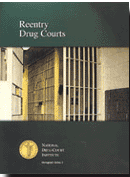Part 3: The ‘Specialty Sentencing Court” as a Problem-Solving System
The idea that sentencing courts ought to be special and distinct entities is not a new one. There are and have been many urban jurisdictions that deal with sentencing and/or probation violations with full time specialty courts. As with the early drug courts of the 1980s, the purpose of special sentencing/probation courts is often to streamline the process and move the offender through as quickly as possible. Concern for how the offender can be best prepared for a return to community with appropriate supervision and/or treatment was and is often overlooked (click on the image on the left for “Reentry Drug Courts”, National Drug Court Institute Monograph Series, No. 3, “Reentry Drug Courts”, JTauber, circa 1999).
Existing sentencing or probation courts should have the responsibility to do more. Like other problem-solving court systems, Sentencing and/or Probation Courts need to create a bond between offender and the court, that among other things, reminds both of their obligations, one to the other. Special Sentencing Court Systems need to deliver evidence-based sentencing practices, processes too complex and demanding for even the most dedicated individual judge. ( “Arming the Courts with Research: Ten Evidence Based Sentencing Initiatives to Control Crime and Reduce Costs”, a PEW monograph, Judge Roger Warren, ret.)
The best Problem-Solving Sentencing Courts will supervise thorugh separate tracks, as do most problem-solving courts in large urban jurisdictions. The Drug, Mental Health, and DUI Courts, though often presided over by the same judge, separate out the offender by the nature of the problem that the offender faces. Though the offender may have more than one serious issue, different problems call for different resources, information, staffing and treatment.
The Veterans Court provides a particularly good model for the Sentencing judge in smaller jurisdictions The Veterans Court has relatively few participants (typically less than 50), and is able to deal with the “Whole Person”. An individual is directed to the Veterans Court because he or she is faced with a criminal case, not because they have a particular issue or problem. The Veteran’s Court is prepared to deal with any and all issues facing the Veteran. To that extent, the Veteran’s court is a particularly good model for a “sentencing court”. The Veterans court mets out appropriate responses, as a sentencing courts should, dealing with many different issues, and providing the appropriate supervision and services as required.
The next segment will look at the importance of the judge in sentencing and monitoring supervision


